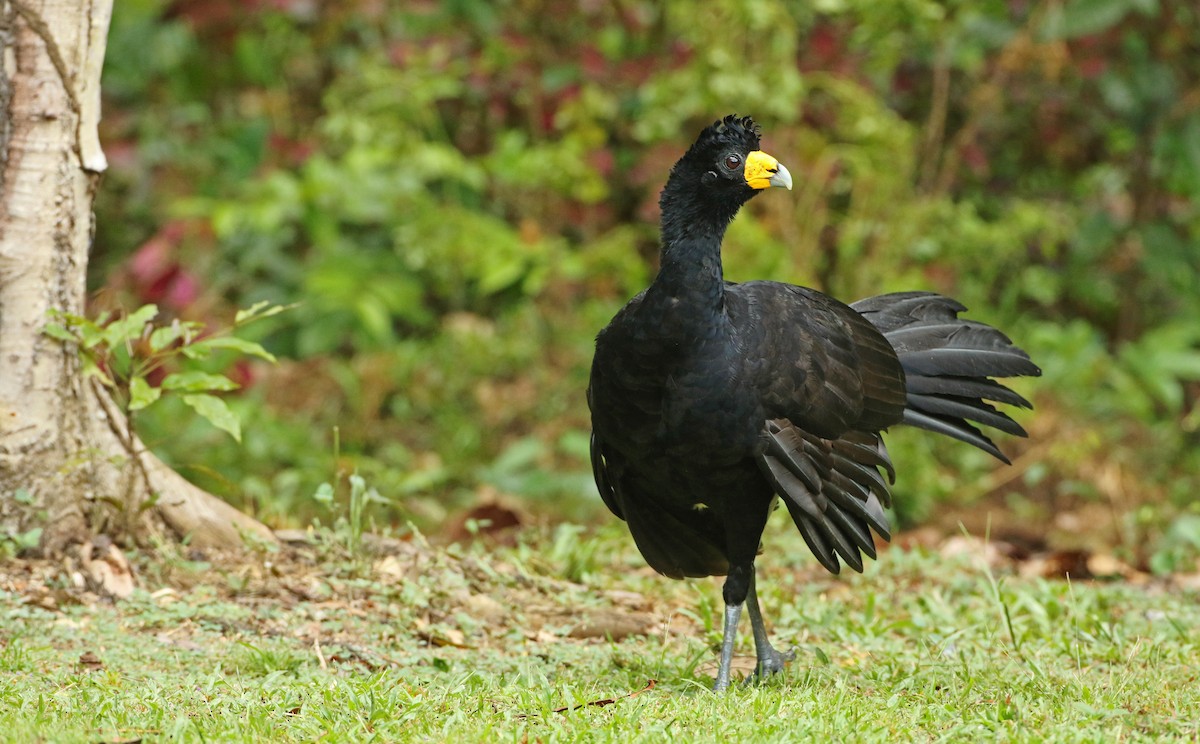The beautiful black currassow. As you lay your eyes upon it, you are mesmerized – the black beauty with a splash of yellow fascinates you. You are drawn to go ever closer to see what this beauty is like up close. The closer you go, the more captivated you are, you begin to find out that it is not only beautiful but it also has its own unique abilities. As you continue to read, you will find out some features of this famous black currassow and what some of its abilities are.
Tip: The black currassow is widely known as powis in Guyana. If you tell anyone about a powis in Guyana, they will quickly recognized that name over the black currassow. So, for simplicity we will refer to the bird as “powis”.
The powis is the largest and the handsomest bird of the family. The various species are all forest-inhabiting birds the size of turkeys, though not as heavy. They have a crest of strongly re-curved erectile feathers and a bright yellow or orange bill frequently with a fleshly cere or a frontal protuberance. They live in the tropical zone south of the Orinoco in the Amazon, Bolivar and Delta Amacuro, alone or in pairs.
Features Of The Powis
- Length – The powis is a large bird reaching about 900 millimetres (35 in) in length.
- Male Color – The male has black upper parts glossed with a purplish sheen and an inconspicuous black crest. The underparts are white.
- Female Color – The female is similar but the crest is barred with white, and the juvenile is black, barred and mottled with reddish-brown and reddish-buff.
- Beak – The skin at the base of the grey beak is yellow or orange but there are no knobs and wattles.
Habitat Of The Powis
The powis is a largely ground-dwelling bird. It lives in the undergrowth in lowland forests and plantations and in riverside thickets. It is found in humid forests in northern South America in Colombia, Venezuela, the Guianas (Guyana) and far northern Brazil. Introduced to Bahamas, Cuba, Jamaica, Haiti, Dominican Republic, Puerto Rico and Lesser Antilles.
Diet Of The Powis
The powis mostly eats fruit, but also consumes buds, shoots, leaves, flowers, seeds, fungi and invertebrates. They are important for dispersing seeds and tend to be found in pairs, or in small groups with young chicks.
Reproduction Of The Powis
Breeding takes place in the rainy season in Suriname while in French Guiana, young are reported in March and September. The powis nests a few meters above the ground in trees, the nest being a platform of sticks. Two eggs are typically laid in a relatively small nest, each egg measuring 9.1 cm × 6.7 cm (3.6 in × 2.6 in) and weighing 200 g (7.1 oz.). The young curassow weighs 123 g (4.3 oz.) upon hatching, 2,760 g (6.1 lbs.) as a half-year-old immature and by a year of age, when fully fledged and independent of parental care, will be about three-quarters of their adult weight at 3,600 g (7.9 lbs.). The lifespan in captivity has reached at least 24 years.
Scientific Classification Of The Powis
The black curassow (Crax alector), also known as the smooth-billed curassow and the crested curassow, is a species of bird in the family Cracidae, the chachalacas, guans, and curassows.
Powis – Crax Alector [Scientific name]
- Kingdom: Animalia
- Phylum: Chordata
- Class: Aves
- Order: Galliformes
- Family: Cracidae
- Genus: Crax
- Species: C. alector
Did You Know? The powis is the only Crax curassow where the male and female cannot be separated by plumage, as both are essentially black with a white crissum (the area around the cloaca), and have a yellow (eastern part of its range) or orange-red (western part of its range) cere.
Amazing Abilities Of The Powis
Their call is unique, a low booming “umm um…umm um umm” sound. It is most commonly heard during early mornings and evenings and is a typical forest sound. They sing on moonlit nights and intermittently during the day. They prefer to walk, but will fly with swooping hops into the trees to sleep or to escape predators with the “click” of an alarm call. When it comes to building their home, the male powis may build a nest and attract a female’s attention to it, though in other cases both members of a pair will built the nest structure. This species has been noted for its rather aggressive temperament, which has been regularly directed at humans while the birds are held in captivity. When a potential predator is near their offspring, powis have been noted to engage in a distraction display, feigning injury. When attacking humans, the powis leap in fluttering flight and scratch about the head, targeting the eyes.
Powis In Guyana
Amerindians use the powis flight feathers to fletch their arrows, and their large size (an adult weighs about 2.8 kg) makes them a target food resource. Early in the morning, two family groups of powis can be commonly seen at the base of Iwokrama’s Canopy Walkway as they patrol their territory and hunt for food. Powis can also be found in the Zoo located in Georgetown, Guyana. When you see it, you will be amazed at how handsome and large this bird really is.
Article References:
- http://www.guyanawildlife.com/animaldetails.asp?animalid=53
- https://www.stabroeknews.com/2013/features/01/27/black-curassow/
- https://www.kaieteurnewsonline.com/2012/11/18/the-powis-crax-alector/
- https://en.wikipedia.org/wiki/Black_curassow
Discover more from Things Guyana
Subscribe to get the latest posts sent to your email.







